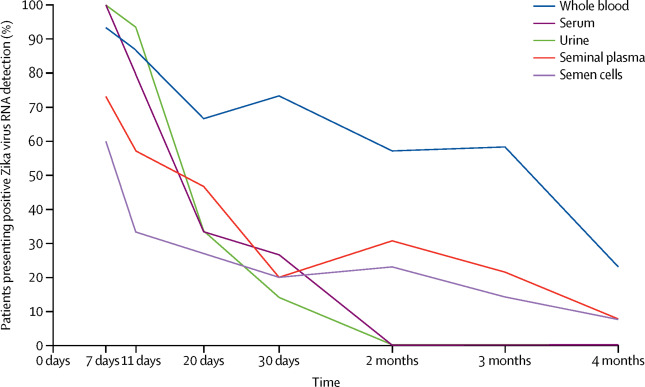The Lancet Infectious Diseases ( IF 56.3 ) Pub Date : 2017-08-21 , DOI: 10.1016/s1473-3099(17)30444-9 Guillaume Joguet , Jean-Michel Mansuy , Giulia Matusali , Safouane Hamdi , Marie Walschaerts , Lynda Pavili , Stefanie Guyomard , Nadia Prisant , Pierre Lamarre , Nathalie Dejucq-Rainsford , Christophe Pasquier , Louis Bujan

|
Background
Evidence of human sexual transmission during Zika virus emergence is a matter of concern, particularly in procreation, but to date, kinetics of seminal shedding and the effects of infection on human reproductive function have not been described. To investigate the effects of Zika virus infection on semen and clearance of Zika virus from semen and body fluids, we aimed to study a cohort of Zika virus-infected men.
Methods
This prospective observational study recruited men presenting with acute Zika virus infection at Pointe-à-Pitre University Hospital in Guadeloupe, French Caribbean, where a Zika virus outbreak occurred between April and November, 2016. Blood, urine, and semen were collected at days 7, 11, 20, 30, 60, 90, and 120 after symptom onset, and semen characteristics, such as total sperm count, sperm motility, vitality, and morphology, and reproductive hormone concentrations, such as testosterone, inhibin, follicle-stimulating hormone, and luteinising hormone, were assessed. At days 7, 11, and 20, semen was processed to isolate motile spermatozoa. Zika virus RNA was detected by RT-PCR using whole blood, serum, urine, seminal plasma, semen cells, and motile spermatozoa fractions. Zika virus was isolated from different sperm fractions on Vero E6 cultures.
Findings
15 male volunteers (mean age 35 years [SD 5; range 25–44) with acute Zika virus infection and positive Zika virus RNA detection in blood or urine were enrolled. Total sperm count was decreased from median 119 × 106 spermatozoa (IQR 22–234) at day 7 to 45·2 × 106 (16·5–89·6) at day 30 and 70 × 106 (28·5–81·4) at day 60, respectively, after Zika virus infection. Inhibin values increased from 93·5 pg/mL (IQR 55–162) at day 7 to 150 pg/mL (78–209) at day 120 when total sperm count recovered. In motile spermatozoa obtained after density gradient separation, Zika virus RNA was found in three of 14 patients at day 7, four of 15 at day 11, and four of 15 at day 20, and replication-competent virus was found in the tested patient. Seminal shedding kinetics seemed heterogeneous among patients. Whole blood was the fluid most frequently positive for Zika virus RNA (62 of 92 samples) and three patients remained positive at day 120.
Interpretation
Semen alterations early after acute Zika virus infection might affect fertility and could be explained by virus effects on the testis and epididymis. Frequency of shedding and high viral load in semen, together with the presence of replicative virus in a motile spermatozoa fraction, can lead to Zika virus transmission during sexual contact and assisted reproduction procedures. Whole blood seems to be the best specimen for Zika virus RNA detection, diagnosis, and follow-up.
Funding
Agence de la Biomédecine/Agence Régionale de Santé de la Guadeloupe/Inserm-REACTing.
中文翻译:

寨卡病毒急性感染对精子和体液中病毒清除的影响:前瞻性观察研究
背景
寨卡病毒出现期间人类性传播的证据是一个令人关注的问题,尤其是在繁殖中,但迄今为止,尚未描述精液脱落的动力学和感染对人类生殖功能的影响。为了研究寨卡病毒感染对精液的影响以及从精液和体液中清除寨卡病毒的情况,我们旨在研究一组感染寨卡病毒的男性。
方法
这项前瞻性观察性研究在法国加勒比海瓜德罗普岛的Pointe-à-Pitre大学医院招募了患有急性寨卡病毒感染的男性,该医院在2016年4月至11月之间爆发了寨卡病毒。在第7天收集了血液,尿液和精液症状发作后的11、20、30、60、90和120,精液特征(例如总精子数量,精子活力,活力和形态)以及生殖激素浓度(例如睾丸激素,抑制素和促卵泡激素)和黄体生成素,进行了评估。在第7、11和20天,处理精液以分离能活动的精子。使用全血,血清,尿液,精浆,精液和能动精子级分,通过RT-PCR检测寨卡病毒RNA。从Vero E6培养物中的不同精子级分中分离出寨卡病毒。
发现
招募了15名男性志愿者(平均年龄35岁[SD 5;范围25-44]),他们患有急性寨卡病毒感染并且血液或尿液中的寨卡病毒RNA检测阳性。总精子数量从第7天的中位数119×10 6精子(IQR 22–234)降至第30天的45·2×10 6(16·5–89·6)和70×10 6寨卡病毒感染后第60天(28·5–81·4)。当精子总数恢复时,抑制素值从第7天的93·5 pg / mL(IQR 55–162)增加到第120天的150 pg / mL(78–209)。在密度梯度分离后获得的活动性精子中,在第7天的14例患者中有3例发现Zika病毒RNA,在第11天的15例中有4例,在第20天的15例中有4例发现了复制病毒。精子脱落动力学在患者之间似乎是异质的。全血是寨卡病毒RNA最常呈阳性的液体(92个样本中的62个),三名患者在第120天仍呈阳性。
解释
急性寨卡病毒感染后早期精液改变可能会影响生育能力,并且可以通过病毒对睾丸和附睾的影响来解释。精液脱落的频率和高病毒载量,以及运动性精子部分中存在复制性病毒,可导致寨卡病毒在性接触和辅助生殖过程中传播。全血似乎是Zika病毒RNA检测,诊断和随访的最佳标本。
资金
法新社/瓜德罗普岛圣安东尼奥市/ Inserm-REACTing。


























 京公网安备 11010802027423号
京公网安备 11010802027423号